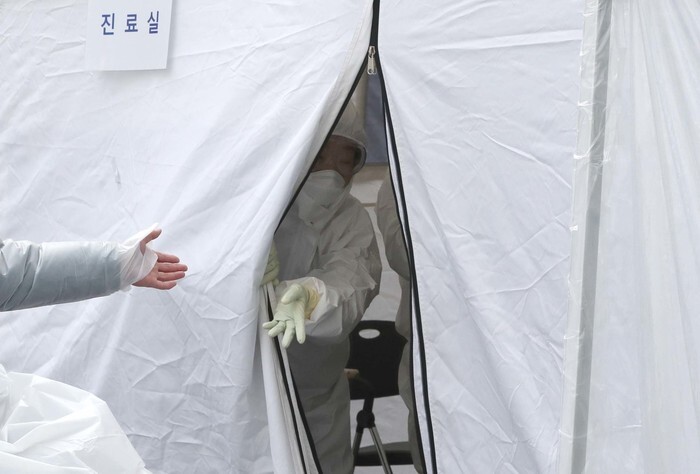hankyoreh
Links to other country sites 다른 나라 사이트 링크
[Editorial] Media needs to stop sensationalized reporting on novel coronavirus

The number of people subject to novel coronavirus infection testing continues to increase. Hopefully, this broader quarantine network will help to filter out infected persons -- but we also cannot rule out the possibility that the infections could spread as people descend upon the testing clinics all at once. Infectious disease experts have been desperately stressing the need to respond calmly and avoid excessive panic or sensationalized reporting.
In that sense, the press conference held on the evening of Feb. 6 by the Korean Society of Infectious Diseases was a timely gesture at a moment when South Koreans are feeling very anxious. The government should pay heed to the experts’ advice that the most important thing is to stop the infections within hospitals, which was a crucial factor in the escalation of the MERS outbreak in 2015, and that the roles of health centers, national and public hospitals, and private hospitals should be distinguished by stage if the spread increases. The press community in particular should take to heart the remarks of one expert who argued that the media was “generating unnecessary panic” and suggested that society “could end up panicking or reacting calmly depending on how things are worded.”
Since early on in this situation, a lot of news outlets have been plastering their pages with titles like “Running loose in Gangnam, Ilsan, and Pyeongtaek,” “Quarantine breached,” and “Where is the control tower?” One article ended up causing confusion when it reported a different location before the temporary facilities for Koreans repatriated from Wuhan had been finalized. Unverified claims about there being “over 90,000 infections in China” or “a single patient infecting as many as 14 others” and reports quoting a British article speculatively linking the infection to a Wuhan pathogen research facility go against rule one of infectious disease reporting, which is that you should only provide the information that has been proven accurate to date, and that it should have a reliable basis.
Amid protests from viewers and readers, close-up images of the temporary facilities have been taken down as violating the overseas Koreans’ privacy, along with misreporting about life inside. This sort of common-sense rule is observed by the world’s best news outlets regardless of government policy; it is incomprehensible that some of South Korea’s news outlets continue using disease names that include a particular region, which could encourage discrimination and feelings of hatred.
Already, there have been a few cases where policies have been overturned after confusion with the government’s announcements. It is also true that the public grows very uneasy when the release of information about the patients’ movements is delayed. It is not appropriate for the government to object excessively to the press’s legitimate criticism and monitoring role. But the media community should also reflect on whether they have been encouraging distrust with their use of sensationalist language in a search for more clicks. If public health and disease control officials end up adopting policies for show or focusing their energies on disputing and reacting to claims because of the media attention, it’s the public who suffers.
Please direct comments or questions to [english@hani.co.kr]

Editorial・opinion
![[Column] Has Korea, too, crossed the Rubicon on China? [Column] Has Korea, too, crossed the Rubicon on China?](https://flexible.img.hani.co.kr/flexible/normal/500/300/imgdb/original/2024/0419/9317135153409185.jpg) [Column] Has Korea, too, crossed the Rubicon on China?
[Column] Has Korea, too, crossed the Rubicon on China?![[Correspondent’s column] In Japan’s alliance with US, echoes of its past alliances with UK [Correspondent’s column] In Japan’s alliance with US, echoes of its past alliances with UK](https://flexible.img.hani.co.kr/flexible/normal/500/300/imgdb/original/2024/0419/2317135166563519.jpg) [Correspondent’s column] In Japan’s alliance with US, echoes of its past alliances with UK
[Correspondent’s column] In Japan’s alliance with US, echoes of its past alliances with UK- [Editorial] Does Yoon think the Korean public is wrong?
- [Editorial] As it bolsters its alliance with US, Japan must be accountable for past
- [Guest essay] Amending the Constitution is Yoon’s key to leaving office in public’s good graces
- [Editorial] 10 years on, lessons of Sewol tragedy must never be forgotten
- [Column] A death blow to Korea’s prosecutor politics
- [Correspondent’s column] The US and the end of Japanese pacifism
- [Guest essay] How Korea turned its trainee doctors into monsters
- [Guest essay] As someone who helped forge Seoul-Moscow ties, their status today troubles me
Most viewed articles
- 1[Column] The clock is ticking for Korea’s first lady
- 2Hong Se-hwa, voice for tolerance whose memoir of exile touched a chord, dies at 76
- 3After 2 months of delayed, denied medical care, Koreans worry worst may be yet to come
- 4[Column] Has Korea, too, crossed the Rubicon on China?
- 5US overtakes China as Korea’s top export market, prompting trade sanction jitters
- 6Samsung barricades office as unionized workers strike for better conditions
- 7[Correspondent’s column] In Japan’s alliance with US, echoes of its past alliances with UK
- 8All eyes on Xiaomi after it pulls off EV that Apple couldn’t
- 9[Correspondent’s column] The US and the end of Japanese pacifism
- 10[Guest essay] How Korea turned its trainee doctors into monsters